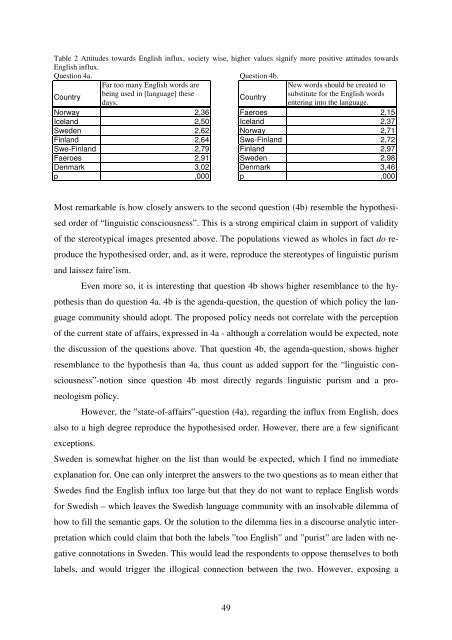Hør dog hvad de siger - Note-to-Self: Trials & Errors
Hør dog hvad de siger - Note-to-Self: Trials & Errors
Hør dog hvad de siger - Note-to-Self: Trials & Errors
Create successful ePaper yourself
Turn your PDF publications into a flip-book with our unique Google optimized e-Paper software.
Table 2 Attitu<strong>de</strong>s <strong>to</strong>wards English influx, society wise, higher values signify more positive attitu<strong>de</strong>s <strong>to</strong>wards<br />
English influx.<br />
Question 4a.<br />
Country<br />
Far <strong>to</strong>o many English words are<br />
being used in [language] these<br />
days.<br />
Norway 2,36<br />
Iceland 2,50<br />
Swe<strong>de</strong>n 2,62<br />
Finland 2,64<br />
Swe-Finland 2,79<br />
Faeroes 2,91<br />
Denmark 3,02<br />
p ,000<br />
49<br />
Question 4b.<br />
Country<br />
New words should be created <strong>to</strong><br />
substitute for the English words<br />
entering in<strong>to</strong> the language.<br />
Faeroes 2,15<br />
Iceland 2,37<br />
Norway 2,71<br />
Swe-Finland 2,72<br />
Finland 2,97<br />
Swe<strong>de</strong>n 2,98<br />
Denmark 3,46<br />
p ,000<br />
Most remarkable is how closely answers <strong>to</strong> the second question (4b) resemble the hypothesi-<br />
sed or<strong>de</strong>r of “linguistic consciousness”. This is a strong empirical claim in support of validity<br />
of the stereotypical images presented above. The populations viewed as wholes in fact do re-<br />
produce the hypothesised or<strong>de</strong>r, and, as it were, reproduce the stereotypes of linguistic purism<br />
and laissez faire’ism.<br />
Even more so, it is interesting that question 4b shows higher resemblance <strong>to</strong> the hy-<br />
pothesis than do question 4a. 4b is the agenda-question, the question of which policy the lan-<br />
guage community should adopt. The proposed policy needs not correlate with the perception<br />
of the current state of affairs, expressed in 4a - although a correlation would be expected, note<br />
the discussion of the questions above. That question 4b, the agenda-question, shows higher<br />
resemblance <strong>to</strong> the hypothesis than 4a, thus count as ad<strong>de</strong>d support for the “linguistic con-<br />
sciousness”-notion since question 4b most directly regards linguistic purism and a pro-<br />
neologism policy.<br />
However, the ”state-of-affairs”-question (4a), regarding the influx from English, does<br />
also <strong>to</strong> a high <strong>de</strong>gree reproduce the hypothesised or<strong>de</strong>r. However, there are a few significant<br />
exceptions.<br />
Swe<strong>de</strong>n is somewhat higher on the list than would be expected, which I find no immediate<br />
explanation for. One can only interpret the answers <strong>to</strong> the two questions as <strong>to</strong> mean either that<br />
Swe<strong>de</strong>s find the English influx <strong>to</strong>o large but that they do not want <strong>to</strong> replace English words<br />
for Swedish – which leaves the Swedish language community with an insolvable dilemma of<br />
how <strong>to</strong> fill the semantic gaps. Or the solution <strong>to</strong> the dilemma lies in a discourse analytic inter-<br />
pretation which could claim that both the labels ”<strong>to</strong>o English” and ”purist” are la<strong>de</strong>n with ne-<br />
gative connotations in Swe<strong>de</strong>n. This would lead the respon<strong>de</strong>nts <strong>to</strong> oppose themselves <strong>to</strong> both<br />
labels, and would trigger the illogical connection between the two. However, exposing a



